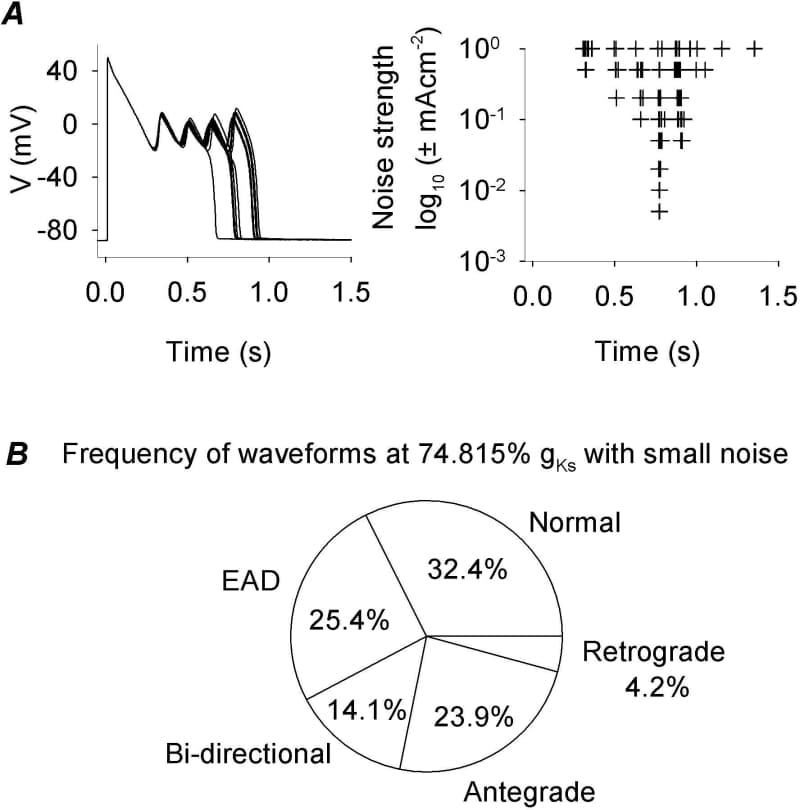One hypothesis for arrhythmogenesis is that a spontaneous ectopic excitation occurring during the vulnerable window of a propagating wave can initiate reentry. This has been demonstrated experimentally and computationally with artificial initiation methods (Starmer et al. 1993; Clayton & Holden, 2002) but spontaneous onset of reentry is rarely observed. The ectopic events that leads to early afterdepolarizations (EADs) in single cells, unidirectional propagations in 1-D fibre, reentrant spiral waves in 2-D tissue and rotors and scroll rings in 3-D slabs, could be the result of stochastic perturbations amplified in tissue regions that are near to bifurcation points. Therefore, a deterministic Luo-Rudy ventricular tissue (Faber & Rudy, 2000) was stochastically perturbed to determine the probability and conditions for spontaneous initiation of an ectopic beat and reentry (Clayton et al. 2003). EADs can be caused by low current density of the fast and slow delayed rectifying K+ currents (IKr, IKs), and incomplete inactivation of fast Na+ current. M cells, with the least IKs density, following a long diastolic interval are most prone to EADs. Therefore, the maximum conductance of IKs (gKs) of a M cell was reduced to 83% of the standard value, just below the critical point of producing an EAD. Addition of a small noise current at this critical gKs can trigger or reduce EADs in a single cell (Figure 1A). However, this bifurcation point is sensitive to [Na+]i: high [Na+]i will push the critical gKs to a lower level. In a homogenous 1-D tissue, the critical level of gKs is further reduced due to the electronic spread of membrane potential. The propagating wave develops ectopics as gKs is reduced to 74.8%. An ectopic can be a localised EAD or a bi-directional source, i.e. a focus. With gKs at 74.815%, a small noise current (± 0.1 mAcm-2) evokes unidirectional propagations: (1) antegrade, equivalent to an ectopic; (2) retrograde, equivalent to a reentrant source. Fluctuations in membrane potential triggered ectopics can initiate reentry. However, such potentially reentrant activity occurred with a low probability (3 out of 71 cases), and was confined in a narrow range within the parameter space (0.03%) (Fig. 1B).
University of Bristol (2005) J Physiol 567P, PC14
Poster Communications: Reentry initiated by spontaneous early afterdepolarizations in a ventricular virtual tissue
Tong, Wing Chiu; Clayton, Richard H; Holden, Arun V;
1. Computational Biology Laboratory, University of Leeds, Leeds, United Kingdom. 2. Department of Computer Science, University of Sheffield, Sheffield, United Kingdom.
View other abstracts by:
Figure 1. A fffect of noise levels (± 0.005 to 1 mAcm-2) on action potentials (APs) for M cells at 83% gKs. Each combination is repeated 20 times. Left superimposed APs with noise at ± 0.1 mAcm-2; right action potential durations of all cases. B frequencies of different propagations with 74.815% gKs and noise (± 0.1 mAcm-2).
Where applicable, experiments conform with Society ethical requirements.

